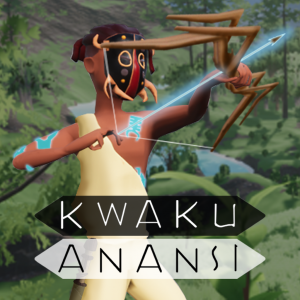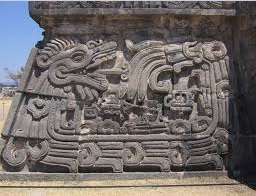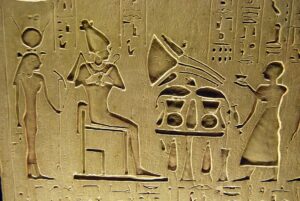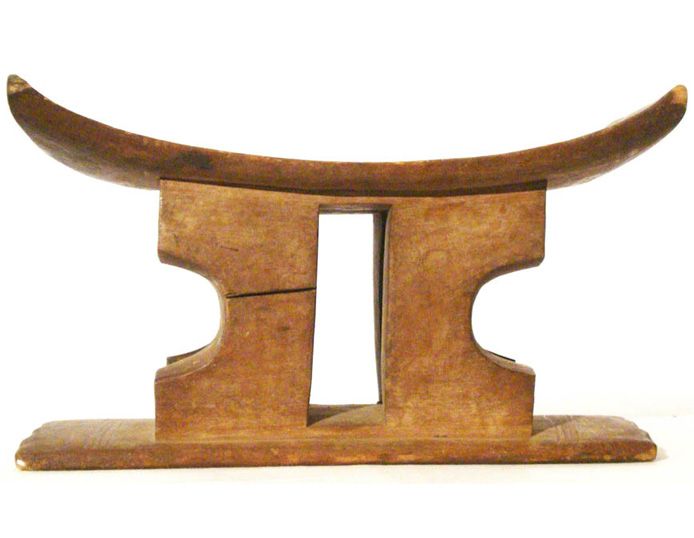
It is often by examining artifacts of culture that we can make links between the present and the past. This is because culture is often cherished and preserved, and artifacts of culture connect us to who we are as a people. that often involves a link with our past.
In this article, I would like to share some curious similarities between three collections of people separated by both distance and time. These three are the Akan people of West Africa, what we know of as the Ancient Egyptians of the Nile Delta, and those Polynesian peoples who have preserved their culture on islands in the Pacific Ocean for millennia.
As I studied some cultural artifacts of these three peoples, I noticed some uncanny similarities (in some cases, I would argue that the instances are isometric, or the same) among these artifacts. In particular, I would like to bring attention to artifacts used in chieftaincy and among royal households. This is because over the past years that I have been studying the culture of the Akan, of other Africans, and other indigenous peoples around the world, I have come to learn that much culture is preserved within royal families, households and within the royal court. That culture tends to be demonstrated in ritual settings during festivals and important occasions. This becomes part of the identity of the people.
In the case of these three people: the Akan, the Ancient Egyptians, and the Polynesians, it came as a pleasant surprise the degree to which these artifacts are similar. I believe that this is not a coincidence. In this article, after I present the evidence of similarities, I shall propose an explanation for why these three cultures separated by distance and time have these similarities.
The cultural artifacts to be discussed will be classified into three categories: (a) fly-whisks, (b) headrests and stools, and (c) swords and weapons. Let us examine each of these categories, one at a time.
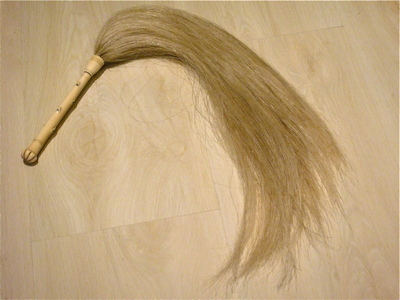
Fly-whisks
Interestingly, the fly swatter, or its variants, is an artifact commonly held by Akan royalty, especially when they are sitting in state. Now, one may notice that it is not only Akan royalty among the people of West Africa that hold such objects, or their variants. I have also noticed that the fly swatter is sometimes held by powerful medicine people. In the photo below, one would see what I am calling a fly swatter, held in the hand of Otumfuo Osei Tutu II, the reigning monarch of the Asante branch of the Akan people of West Africa.

So, it was to my surprise to learn that at least in one Polynesian culture, their chiefs also hold these fly-whisks. The culture I shall include in this article is the Samoan culture. Among the Samoans, the chiefs hold fly-whisks as a form of authority. The artifact is said to symbolize wisdom. Below, in the photo, we can see a fly-whisk held by Samoan paramount chief Mata’afa Losefo (1832 – 1912). In his hands, you will find him holding a fly-whisk:
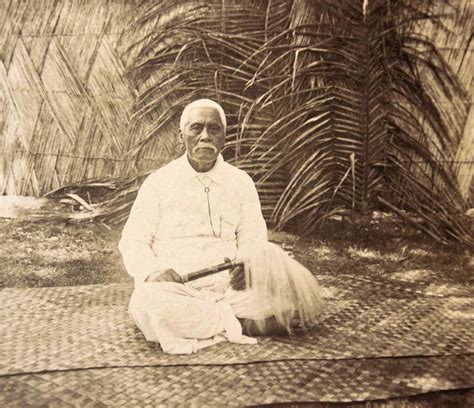
I was to learn later on that among the people of Thailand, fly-whisks are also included in the royal regalia. This curious fact will be highlighted again later in the article, after examining the instances of evidence.
What about the case of the Ancient Egyptians? Well, we do not have photos of them, as we do of contemporary monarchs. At least, not photos that are publicly available, to my knowledge. When examining frescoes of Ancient Egyptian art, I however came across what I saw to be an interesting instance of an artifact which, while not being a fly-whisk, looks similar to one. It also appeared to serve as an artifact carried by rulers or those of authority. This is the flail, an object that can be used for processing grain and husks. Among Ancient Egyptian rulers of Pre-Dynastic and early dynastic times (and afterward), the flail was used as a symbol of authority among rulers, together with another artifact called the crook. The crook brings about images of a shepherd’s crook, and the flail pertains to land fertility. Both are associated with the Ancient Egyptian deity Asar, also known as Osiris among the Greeks.
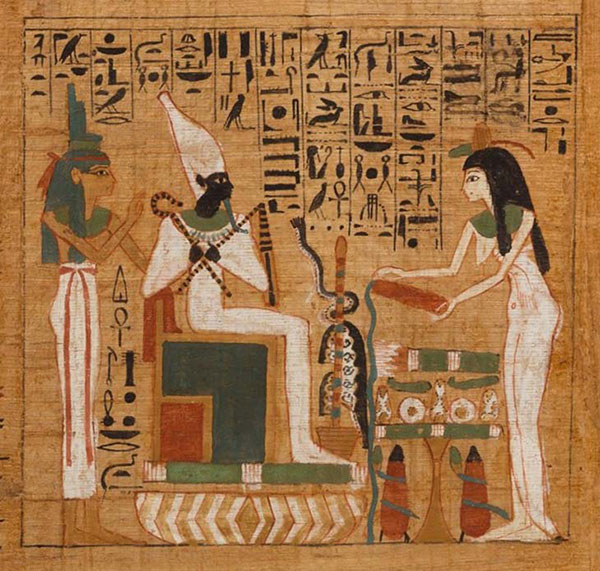
Having touched upon fly-whisks among Akan and Samoan royalty, and a similar regal artifact among Ancient Egyptians, we shall now proceed to discussing headrests and stools used by royalty of the same three groups.
Headrests and Stools
This second group of artifacts offers the most amount of interesting evidence and parallels among the three groups of people who are the main subject groups of this article. This time, let us start with the Polynesian groups, because there are many very interesting examples of the same shaped object being used sometimes as a headrest and other times as a stool, among royalty in Polynesia. The overall shape of the object can be shown in the image at the very beginning of this article. I first learned that the chiefs of the Polynesian people that inhabit the Cook Islands sit on a stool that is very similar to Akan and Egyptian variants. The Cook Islands people, I believe, belong to the Maori, a branch of the Polynesian family. The stool shown below is from Atiu Island, which is one of the Cook Islands. Among these people, the stool is called no’oanga, which I found interesting because a word for chair in the Akan language is egua. Not exactly similar, but somewhat.
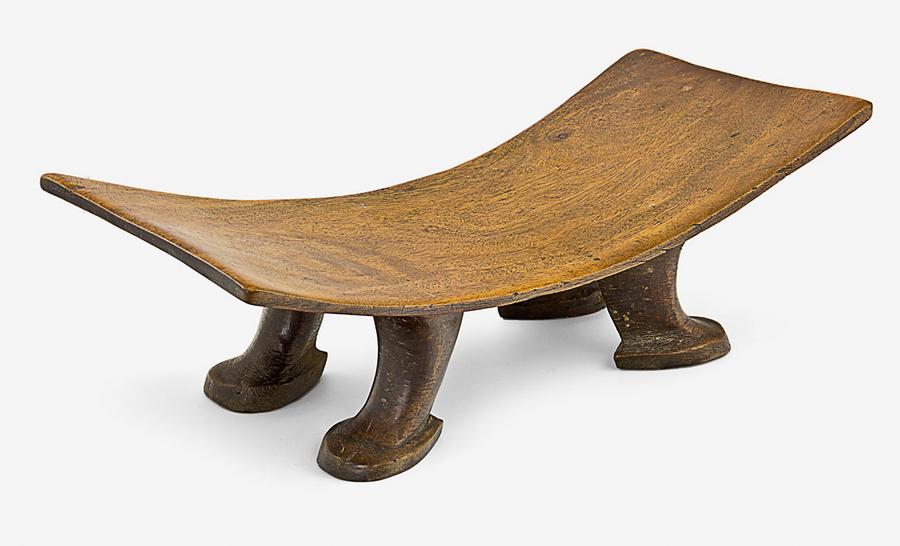
Those that are conversant with Akan culture will notice an unmistakable similarity in the shape of the part that actually forms the seat. In my study of indigenous Polynesian stools, this example was the most marked and remarkable, especially as it is associated with royalty. I also came across a stool used by the Kiribati people, although I have not yet connected use of the stool exclusively with royalty (i.e., the stool below may also be used by non-royals). Kiribati is an Island nation in the Pacific. They are Oceanians, a larger group in which Polynesians also below.
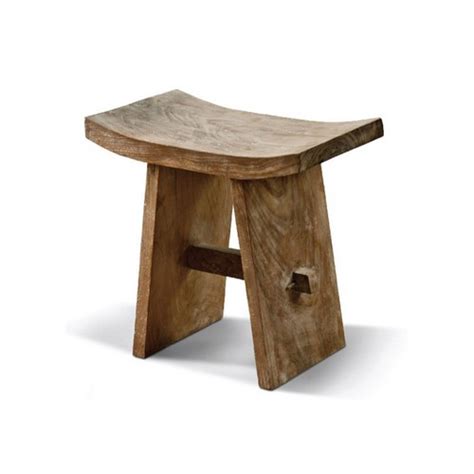
Returning to Polynesia proper, I chanced upon a few more examples of the same shaped object, but used by royalty as a headrest, rather than as a stool. For example, among the people of Tonga, another Island in the pacific, the chiefs used headrests that have the same or a similar shape with some of the stool artifacts already displayed in this article. Let us consider the example below, because the shape of the artifact is very similar to that of the no’oanga stool used by the Cook Islands chiefs.
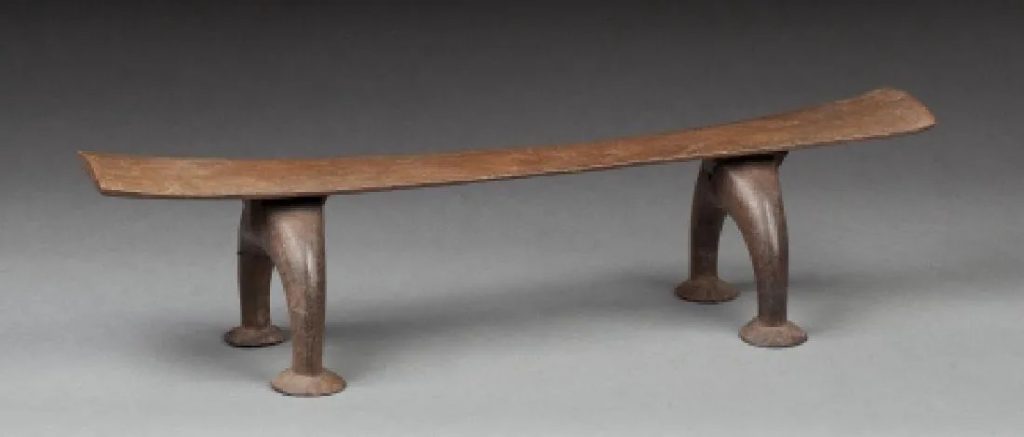
Similarly, the people of Tahiti also have a headrest that to me looks practically of the same basic design, but with some stylistic differences. Let us examine the Tahiti example below.
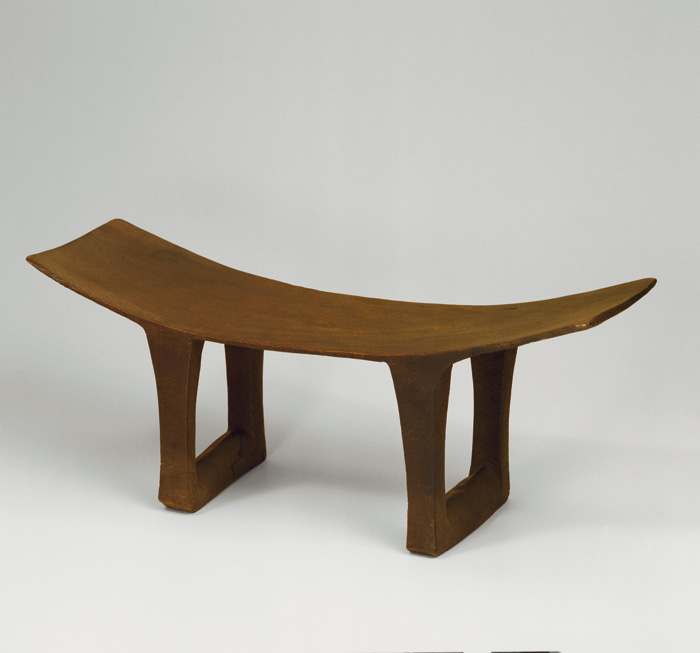
And the final Polynesian example for this article will be from Fiji, where the chiefs have used a variety of headrests, as the photo below shows.
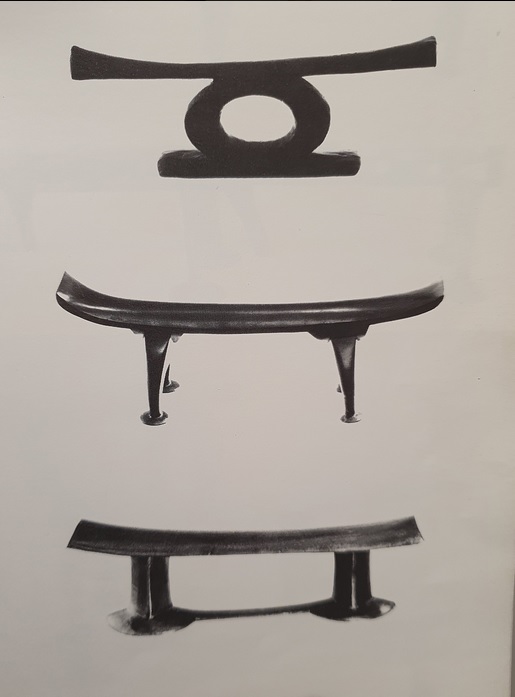
By now, it is emerging that the same basic design of this cultural artifact that has been used by Polynesian royalty can function both as a headrest and as a stool. This is attested in the examples shown above for Tonga, Tahiti and Fiji, where the artifact functions as a headrest, and in the Cook Islands, where it functions as a stool.
Indeed, this line of thinking becomes even more intriguing when we consider that in Ancient Egypt, the same cultural artifact we have been discussing in this second category of artifacts used by royalty was used both as a headrest and as a stool, within the same culture. In other words, over the period when Ancient Egyptian culture flourished, we have examples of headrests and stools having the same basic design. I shall give one example each, from Ancient Egypt. Let us start with one example of a headrest from this culture, shown in the photo below.
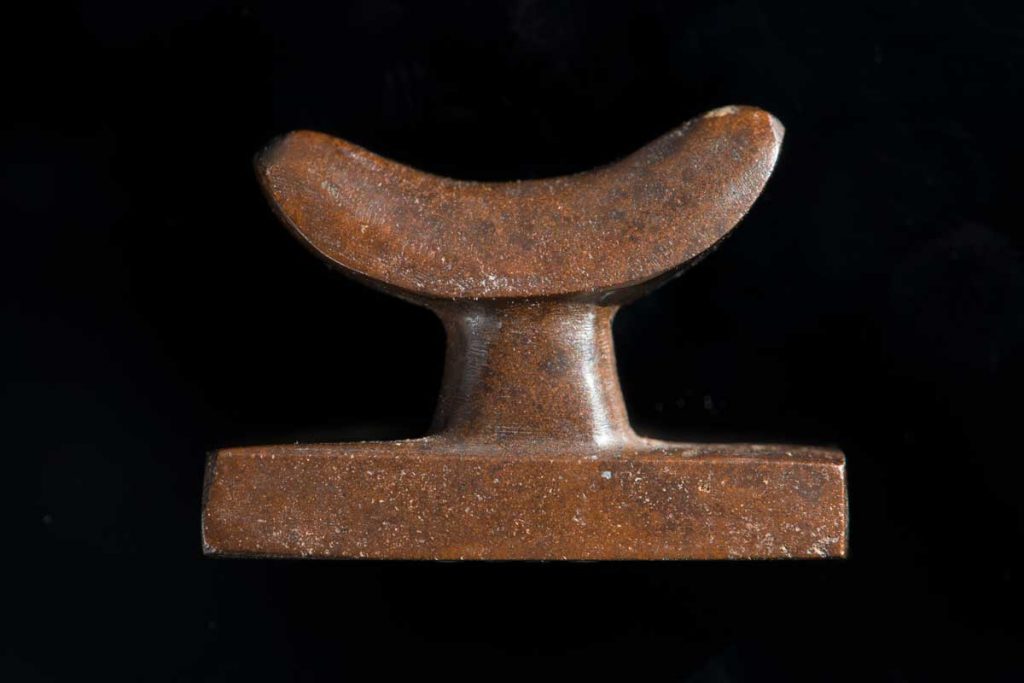
Now, it is fairly evident that the basic shape that the Ancient Egyptian headrest artifact above has is identical to those found from the Polynesian headrest artifacts. The difference in material between the Ancient Egyptian example shown above and the Polynesian ones does not matter. The photo below shows three Ancient Egyptian headrest exhibits on the left that have the same basic pattern as those we have been discussing in this section.
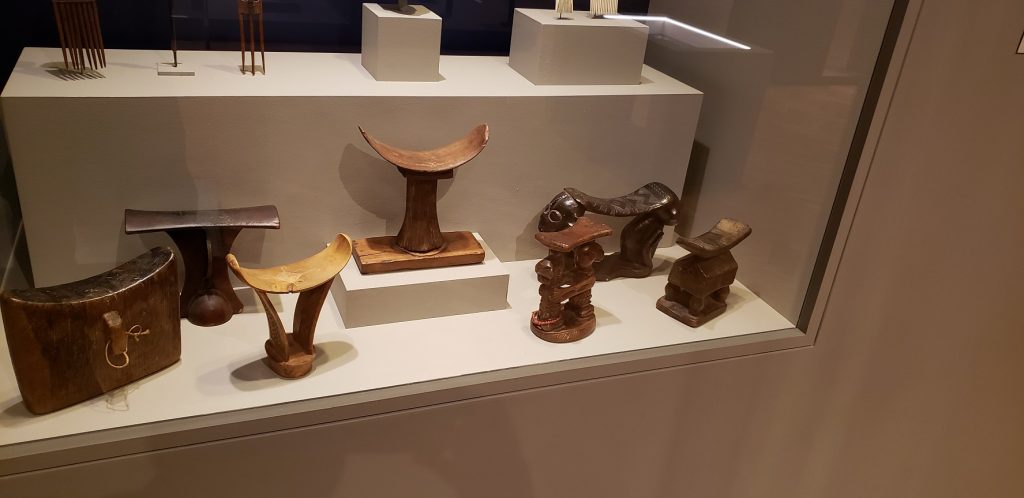
In Ancient Egypt, these headrests were used by the Pharaohs and also by some notables. The stool versions were however used mostly by the Pharaohs, as can be seen in the stool example below, given as one example that has featured in Pharaoh Tutankhamun’s tomb, as well as those of other Pharaohs of the 18th dynasty (as an example).
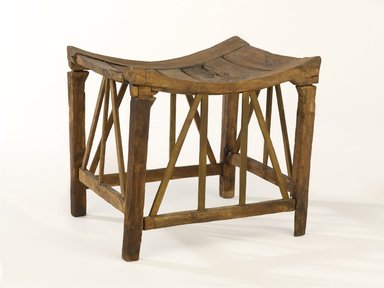
This brings us to West Africa, where the chiefs and queen mothers of various groups among the Akan people (and not only them) use these stools as a symbol of royal office. Sitting on a stool confers rulership over a given people, among the Akan people. The stools are important, not only to designate rulership among the living, but also as a connection to the ancestors, specifically those ancestors who were once rulers of Akan groups in earlier times, and who once occupied a given stool. Therefore, among the Akan people, association between the royal stools and rulership is strong indeed. Below, one can find one example of an Akan stool that may commonly be found in royal settings.
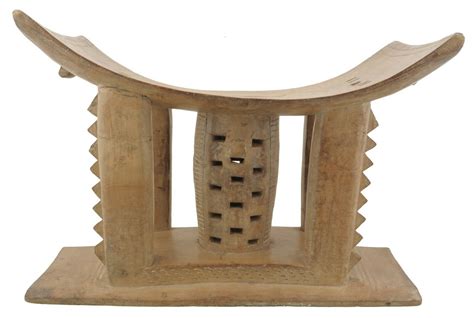
It is clear to me, from these examples across three cultures, that there is a royal artifact that crosses the boundaries of these three cultures. Why this may be the case will be discussed shortly, however before we get into that, there still remains the third category of artifacts to discuss, which arguably provide some even more exciting examples as data, because of the degree to which there is coherence across the examples found in each of the three cultures. This third and final category is concerned with swords and weapons.
Swords and weapons
Since time immemorial, humans have used different kinds of weapons for different reasons. Often for war, hunting or for defense, the sword is one of those weapons that has featured strongly in the history of humanity. However, as those that may have an interest in the esoteric might now, swords are not only used for fighting or for hunting or for defense or even for sport. They can also be used in magical or other ceremonies or rituals. They can also be worn ritualistically as part of traditional regalia.
The swords we are about to discuss may play different roles, but they all seem to have one thing in common. The underlying commonality they all have is an astounding similarity of shape and design. They all have sort of a sickle shape or a curve. I argue that the shape is similar enough across three peoples separated by distance and time that it may not be a coincidence.
Let us once again delve into the examples, starting with the Polynesian ones since there are more of them. First, we can have a look at a photo of one example of the clubs that Maori chiefs held. The club has a curved shape, curving in one direction closer to the end of the club.
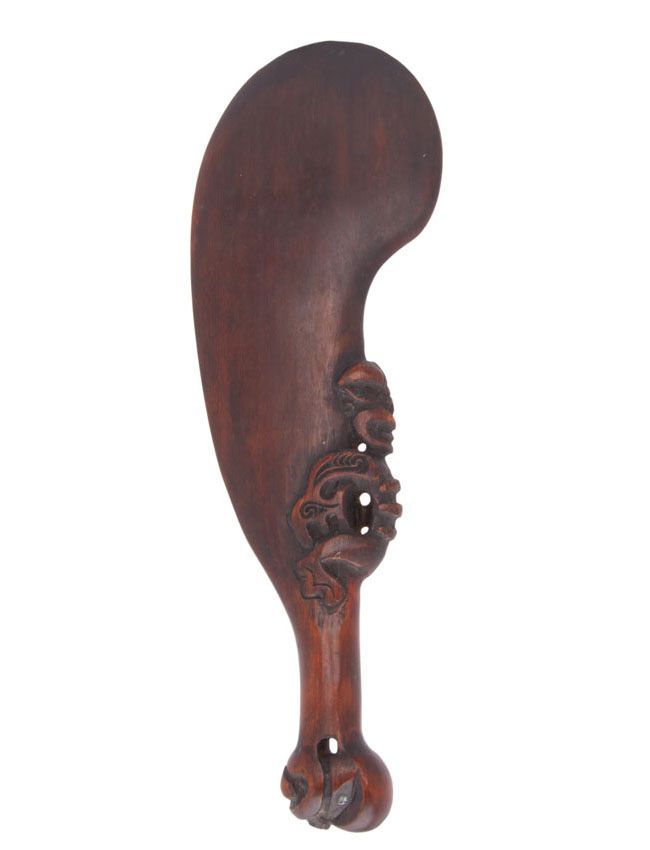
A similar weapon can be found among the Samoan people. One end of the lautau, as it is called, looks more like a blade than like a club. The feature that makes the lautau similar to the Maori club is the manner in which it curves at the end.
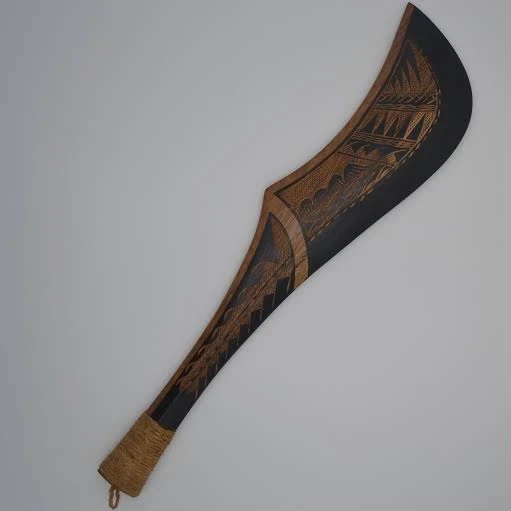
I found these two weapons from Polynesia to be similar to the Akan ceremonial sword, which is also known as the ‘afena’. It has a somewhat curved blade, similar in design to those of the Polynesian chiefs.
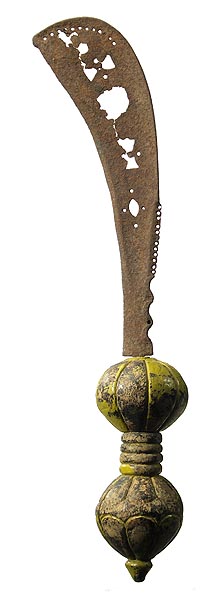
So, at this point, I thought, well, the comparison must end here. There are uncanny similarities between the shapes of swords and clubs used by Polynesian chiefs with those used among the Akan people of West Africa. But then I thought, what about Ancient Egypt? Surely, there should be a connection to Kemet as well, in this aspect as well. So, I looked, and much to my delight, there was. In Ancient Egypt, there was a sword known as a khopesh (sometimes spelt as “khepesh”) which, surprise, surprise, has a curved blade! This curved, sickle-shaped sword existed in Ancient Egypt as early as the pre-Dynastic and early dynastic eras. It was around for much longer, as evidenced by the specimen in the left photo of the composite photo below, which is from the time of Ramesses II, also known as Ramesses the Great, whose reign was in the 19th dynasty.

Of course, we find that Ramesses II himself used a khopesh, as the following image shows.
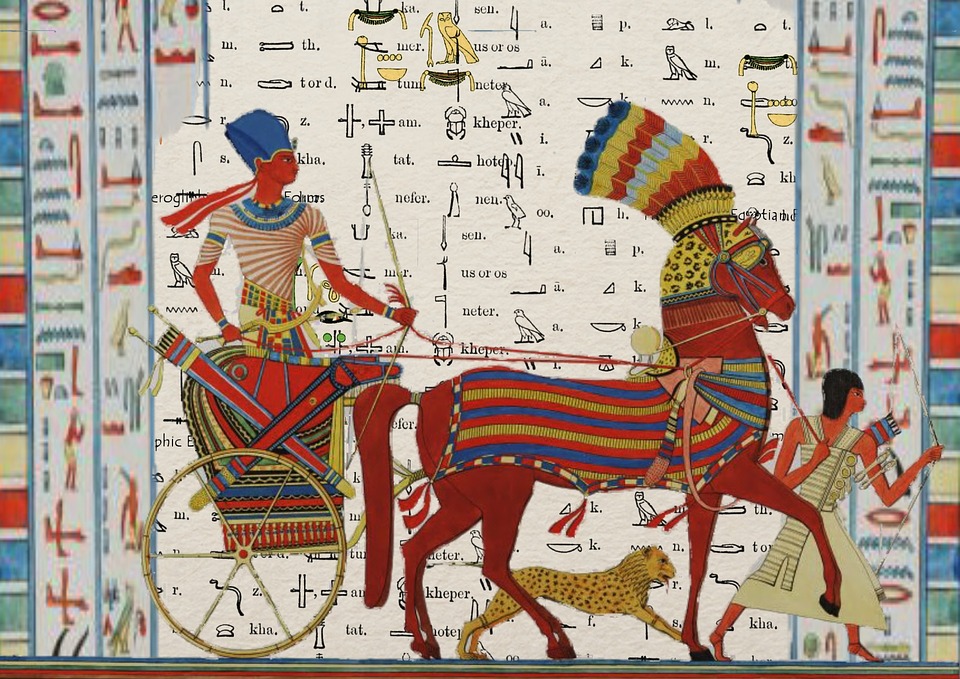
Bringing it all together – A possible explanation
So, we have some evidence presented. Now, to present some thoughts on what it could all mean. I think these strong similarities among all three groups points to the fact that these three cultures have a commonly shared cultural influence, and I also think that this commonly shared cultural influence, if we go far back enough, points to the lost continent of Mu or Lemuria, which I wrote about at length in a book titled Kemetic Alchemy and Tantra. This book details the dispersion of black people from what was known as The Motherland, or Mu, to the pacific islands, to parts of Asia, to the Near East and also to Africa. My theory is that the Polynesians, the Ancient Egyptians and even the Akan people and others in West Africa and elsewhere in Africa were influenced by Mu, which had such a long history before the continent is said to have submerged. Those various peoples that were influenced by Lemurian culture to a lesser or to a greater extent have very similar cultural features, especially when it comes to cultural artifacts such as those that are found among the royal households. The Polynesian peoples are one remnant of the people of Mu, albeit a major remnant. Research carried out by the Ancient Egyptians showed that that culture was at different points influenced by at least two groups of Lemurian travelers. There were the Mayas, and then there were also the Nagas, who came to Ancient Egypt at different times and through different routes. In the paper, I also argue that the Akan people were influenced very likely by a group of Nagas, who left the region of Kemet and Nubia, traveling further west, and settling in what later became the Ghana Empire.
Talk about ancient submerged continents, such as Lemuria and Atlantis often tends to get frowned upon by mainstream academia. This topic is still considered ‘fringe’, or esoteric history, at best. That never stopped me from delving into such areas, because we commonly know that mainstream academia typically lags behind in what is considered to be true or to be cutting edge. The visionaries of today will be vilified today and celebrated tomorrow, or more like decades or centuries after they are dead. That pattern has repeated itself over and over and over again. Even after the great Plato wrote about Atlantis, his accounts are typically frowned upon or simply ignored by the mainstream, because it is an uncomfortable subject. Meanwhile, those that have taken it upon themselves to hoard all the “good stuff” or interesting knowledge about the world, classifying things as “top secret” or above that, or hiding it in esoteric orders, secret societies or even in places like the Vatican library, well this can’t go on forever. So, I go where the interesting data takes me, doing it myself since the government or the church will likely not do it for me. Right now, I have done enough research and examined enough artifacts (besides and unrelated to the ones discussed in this article) to personally convince me of the very likely existence, at one time, of those two continents (Lemuria/Mu, and Atlantis), and the fact that they are no longer accessible in our present time in the normal way. I invite the interested reader to explore the truth of this if they so choose before choosing to close their minds about these topics. For now, however, if you don’t know these things then I shall request that you consider treating these ideas as possibilities until such time as you manage to verify or refute them for yourself.
Let us first start with the Polynesian artifacts. I would like to suggest that the incidence of very similar (and sometimes, virtually identical) cultural artifacts within Polynesia, especially in relation to the headrests points to these cultures having a common origin. There are other aspects of Polynesian culture such as language and chieftaincy systems that also suggests a common cultural origins. So it should come as little surprise that various Polynesian chieftains share a virtually identical headrest. What I do not have in my possession is a photo of a Lemurian headrest, which, if it was similar or identical to the compared headrests, would have settled the case. Instead, I am drawing on other knowledge of association between Polynesian peoples and Lemuria to suggest that it is very possible that their cultural influence was a single source. One example can be seen with the people of Tonga, or the Tu’i Tonga Empire, which was modeled after Lemurian culture. They named their capital Mu’a, which is a clear reference to Mu, or the motherland. Remember too that these Polynesian islands are dispersed over a wide area, with ocean between them. They flourished more or less within their respective groups (there was some cross-cultural interactions as well). So, if they are preserving their culture, living separately, while that some key aspects of that preserved culture are identical or very similar across a wide area of separately living groups, then chances are that there was an original culture of an earlier time from which they all stemmed.
Now, let us move to Ancient Egypt. This was a land that had numerous influences over a long period of time. We can learn that Ancient Egypt was a culture onto itself, that was also influenced by others. The Lemurians came (according to research published by James Churchward), the Atlanteans came (according to the account in the Emerald Tablets of Thoth), the Canaanites came, the Hittites, the Assyrians, the Jews, the Greeks, the Romans and finally the Arabs. So, many came to Ancient Egypt, also known as Kemet. At the very early stages, Ancient Egypt was ruled by black Pharaohs, as has been shown by scholars such as Cheik Anta Diop and Chancellor Williams. Here, we’re talking about the pre-dynastic period, and then the early dynastic periods of the Old Kingdom and early Middle Kingdom. That is, all pre-dynastic, from the 1st to 6th dynasties, and then 11th and 12th dynasties (Mentuhotep II’s resurgence in the 11th dynasty, and the beginning of the Middle Kingdom), and then again in the 25th dynasty, which ruled both Kemet and Nubia. From what I have learned, for these dynasties and the pre-dynastic period, there is strong evidence of rule by black pharaohs. This is important for at least two reasons. First, those black pharaohs of the early periods essentially set up what became known as Ancient Egyptian civilization, and second, there is evidence of migration of blacks from the region, first further south toward Nubia, and later, further west and south, toward West and Southern Africa. What this all means is that essentially, the peoples of West Africa are among the descendants of the Ancient Egyptians, especially those of the very early periods. The Akan people are among the inheritors of Ancient Egyptian culture, and this has been argued and shown by other authors and academics, both mainstream and non-mainstream. Today, it is fairly well-known among non-mainstream academics that West African cultures have descent from Ancient Egyptian culture. Perhaps it may take a few decades or centuries before this becomes more common knowledge, but if enough people verify this as true, eventually it will.
Interestingly, those black Pharaohs of the earlier period of the earlier period of Ancient Egypt had already experienced an Ancient Egypt that had been influenced by Lemurian culture. Mind you, Lemuria had a very old black culture on Earth. Very old. This is what leads me to believe that it was the Lemurians who went out and influenced the culture in Ancient Egypt (it is often said that Egypt was a ‘daughter colony’ of Lemuria, in very ancient times) rather than Egyptians influencing the Polynesians. Black people have three high cultures I know of where they lived and ruled over some periods for millennia. These are the cultures that existed in Kemet (Ancient Egypt), and Nubia, in Mesopotamia, and in Lemuria. In Kemet and Nubia, there were many peoples associated with black culture (i.e., Bantu-types, Chadic, Sudanic). In Mesopotamia, there were Cushitic, Semitic and Sudanic types. In Lemuria, there were a lot of Dravidian-type black people, as well as Polynesians, among others.
I must admit however, that I have thought about the possibility of Ancient Egypt having influenced both Akan and Polynesian cultures as an alternative explanation for the commonalities apparent between the three cultures. It is possible, but I think it is more likely that the influence was from Asia and the pacific, rather than the other way around. I have also thought about the possibility of the influence stemming from a different place, such as from Sumeria/Mesopotamia, but I have not yet accounted for how Mesopotamian cultural artifacts would compare with those of these three cultural groups. Another possibility: could it be the Akan and other Africans that influenced Ancient Egypt and Polynesia? I do not think so, because the migration histories of the Akan at least point to a progressive westward and southward direction, rather than the other way around. Finally, could it just be that this could all be a completely random occurrence, that these artifacts simply arose in their respective cultures independent of any other outside cultures? Possible, but not likely, I think, because the chances of there being such parallel developments are low, if we calculate pure probabilities.
So, for now, my best hypothesis is that the single thread that connects Akan (and likely some other African cultures) with Ancient Egypt and those in Polynesia on the basis of comparison of these cultural artifacts associated with royalty is a common influence that all three cultures that all three cultures have had from the earlier Lemurian culture.
Article Themes: Akan, Polynesia, Royal regalia, Black people, Indigenous cultures

